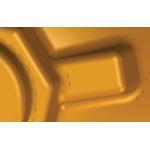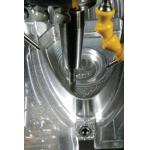Latest News
February 1, 2006
By Peter Dickin
Editor’s Note: This article is an excerpt of a longer piece. The full text of this article is linked here.—DE
Each year, market analyst CIMdata publishes its NC Software and Related Services Market Assessment. CIMData’s 2005 report shows that, in the ten years up to 2004, the three major suppliers of high-end, CAD-integrated CAM systems—Dassault, UGS, and PTC—saw their combined market share fall from almost half of the total to less than one third. This article will look at the reasons for that decline and predict whether the trend will continue in future years.
|
|
| Modern CAM systems can produce accurate parts from CAD models with small gaps. |
Two important points need to be explained first. All the figures quoted here relate to end-user expenditure. This gives a more accurate comparison because otherwise companies like Dassault, which sells mainly through resellers, as do the majority of smaller CAD/CAM vendors, are shown in a poor light compared to those like UGS and PTC that supply the majority of their software direct to their customers.
In addition, the figures for 2004 have been adjusted to take account of the many mergers and acquisitions during the past 10 years. The most significant of these were the acquisitions of SDRC by UGS, of ComputerVision by PTC, and of Matra Datavision by Dassault.
Four major factors can be identified for the change in the CAM market: the growth of mid-range CAD systems; improvements in data translation; increased use of shop-floor programming; and the use of CAD/CAM in new industries.
The Growth of Mid-Range CAD
The term “mid-range” modeler was introduced following the launch of SolidWorks in November 1995. This was followed soon afterwards by the release of Solid Edge and Autodesk Mechanical Desktop. The aim of all three systems was to provide a less-expensive option for small and medium-sized companies that were put off by the high cost of the existing high-end systems.
|
|
| Accurate simulations are a key part of shop-floor programming systems, especially with five-axis machining techniques. |
One of the key differences with the new style of products was their focus purely on CAD. The remaining components of the system, including the CAM functionality, were provided by other developers. Another important difference was that they were sold almost entirely through resellers. The choice of the CAM system to accompany each sale of the CAD system remains up to the reseller and the customer. Only very rarely is this system from one of the integrated system suppliers.
Improved Data Translation
The issue of data translation is a recurring one in any supply chain. However, the question for OEMs and their suppliers should not really be “Can we have perfect translations?” but “Can we have sufficiently accurate translations that no significant information is lost?” Even though the answer to the first question will still be “No,” the answer to the second question will usually be “Yes.”
The most common problems in translated data are surface edges that do not match precisely or that are not trimmed correctly, normals that point in the wrong direction, and surfaces that are duplicated. All these errors are capable of being identified and corrected easily in many CAD/CAM systems. Modern CAM systems are much more tolerant of imperfect data and will usually produce accurate parts even when the translated model is not mathematically perfect.
|
|
| Shop-floor programming is growing in popularity as automated setup tasks free up more time. |
The new generation of communication tools, including e-mail and Internet telephony, mean that complete accuracy is becoming less important rather than more important. It is now easier and quicker to question ambiguous, unclear, or unusual items in a CAD file with the person who sent it, even if that person is many thousands of miles away.
Shop-Floor Machining
In its 1997 report, CIMdata estimated that only 10 percent of CAM systems were used by machinists or other programmers working on the shop floor. By 2004, this percentage had risen to 19 percent, with a further increase to 22 percent predicted for 2005. The opportunity to introduce shop-floor programming has come about because the increased automation in modern machine tools has reduced the time needed to set up each job and so freed up time for other tasks.
To make the transition successfully, companies need CAM software that addresses the particular needs of the shop floor. First, it must be easy to use since machinists are not usually computer specialists. Second, it must offer a wide range of strategies so that the operator can machine the part in the way that he or she wants to, rather than being inhibited by limitations in the software. Third, it should incorporate toolpath visualization and verification facilities so that trials can be run on the computer rather than on the machine. An integrated CAD system that can be used to alter the part design is a hindrance rather than a benefit.
Novel CAM Applications
In its early days, CAD/CAM was associated almost exclusively with the aerospace and automotive industries. More recently, CAD and CAM have been introduced into areas as diverse as sign-making, jewelry production, and furniture manufacture, with most of the business going to smaller, more specialized software developers.
|
|
| The traditional CAD/CAM systems have made little impact in new industries like jewelry. |
The benefits sought by users of CAD/CAM systems in these new areas are basically the same as those sought by more established users. However, this new group of users tends to struggle with systems that require any detailed knowledge of engineering and mathematical principles. In addition, they need software that will work alongside their traditional skills rather than seeking to replace them. The high-end, integrated CAD/CAM systems are unsuitable for both of these reasons, which has encouraged the development of alternative software. These new programs may not offer the same level of engineering precision but they make it easier both to create and to manufacture more artistic products.
Will These Trends Continue?
If the trends above are accepted as the reasons for the decline in the market share of the high-end, integrated systems, it seems certain that further falls will be seen in future. A recent study by the 01Consulting Group has predicted that the sales of mid-range CAD systems in Europe will overtake those of the high-end systems by 2007. The number of companies offering data translation software and services is continuing to grow, making it easier to find successful methods for converting files from one system to another. CIMdata is predicting a further increase of the level of CAM programming that will be carried out on the shop floor. Finally, growth in the more unusual areas for CAD/CAM is likely to be faster than in more established applications.
Clearly, there will always be a demand for high-end integrated systems, especially among the larger and more conservative companies in the automotive and aerospace industries. However, it seems certain that the market share being won by powerful, specialized CAM systems will continue to increase.
Peter Dickin spent 16 years at the plastics and rubber consultancy Rapra Technology in various management positions. For the past 13 years, he has worked for Delcam. You can send him an e-mail about this article by clicking here. Please reference “Specialized CAM, February 2006” in your message.
Putting CAM on the Shop Floor
Putting CAM onto the shop floor gives you several advantages. First, machine operators generally know more about machining—in particular, any unusual features of the machines within their shop. They should, therefore, be better able to select optimum machining parameters for each job. This gives more efficient use of CNC machines and should also ensure higher-quality machining.
In addition, machine operators will be more aware of conditions on the shop floor, in particular the tooling, materials, and machines that are currently available. This will help to improve job scheduling and reduce down time.
|
|
| Five-axis machining strategies that were once only supported by high-end systems are now available more widely. |
Similarly, the machine operator will be able to make any changes to the program that might become necessary on the spot, rather than having to go back to the CAD/CAM operator and wait for new data. The time saved will increase machine utilization and also reduce interruptions to the CAD/CAM department’s other work. —PD
Sidebar caption:
Five-axis machining strategies that were once only supported by high-end systems are now available more widely.
Companies Mentioned
01Consulting Group
Paris, France
Autodesk, Inc.
San Rafael, CA
CIMdata, Inc.
Ann Arbor, MI
Dassault Systemes
Paris, France
Delcam, Inc.
Birmingham, UK
PTC
Needham, MA
SolidWorks Corp.
Concord, MA
UGS Corp.
Plano, TX
UGS Corp./Solid Edge
Huntsville, AL
CAPTIONS
Subscribe to our FREE magazine, FREE email newsletters or both!
Latest News
About the Author
DE’s editors contribute news and new product announcements to Digital Engineering.
Press releases may be sent to them via [email protected].











